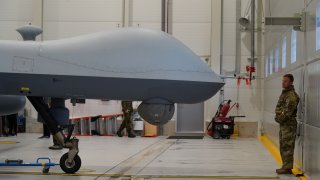Networked Drones Could Head To the Battlefield Sooner Than You Think
Long-range weapons, advanced sensing and AI-enabled targeting will introduce new warfare tactics.
Here's What You Need to Know: There are many new, cross-domain technologies that are improving the ability of the Army to wage war.
Yuma Proving Grounds, Arizona - There are many now-underway tactical adjustments being pursued by the Army as it adapts to new technologies and seeks to transform into a new era of warfare. Among these are the drones, lightning-fast sensing and shooting, air-ground-sea-space attack coordination, and lots of networked weapons systems.
“I think what you are going to see is really the depth and range of the battlefield. It will be a joint-forces fight across hundreds and thousands of miles,” Gen. James McConville, Chief of Staff of the Army, told me during Project Convergence 2020 at Yuma Proving Grounds, Ariz.
The live fire event, which included drone-to-drone networking, AI-enabled sensor-to-shooter pairing in seconds, satellite targeting, drone-fired missiles, direct-fire armored vehicle attacks and long-range destruction of enemy air defenses, was intended to experiment with transformational forms of nearly instant targeting and multi-domain networking.
“We believe we are going to be contested in every single domain which will change how we operate, not just on land but in the sea, air, cyber and space. We will be operating cross-domain. If you look at some of the systems we have, they are going to operate on the ground, they are going to operate in the air and some of them are going to be dependent upon space to get the effects that we need,” McConville said.
The exercise demonstrated an ability to close the targeting loop or decision cycle from detection to fire from as long as twenty minutes down to twenty seconds. One particular innovation enabling this was not only manned-unmanned teaming, but unmanned-unmanned teaming wherein a Gray Eagle drone networked with a forward operating mini-drone called Air Launched Effects. This, as Army leaders described, extended the range, scope and target envelope for attack missions well beyond “line of sight” and what service leaders described to me as the “visibility line.” Moreover, Gen. John Murray, Commanding General of Army Futures Command, told The National Interest that more drone-drone operations we planned in coming years.
“You saw unmanned-unmanned teaming with two air vehicles that were completely autonomous. We are going to continue to expand that. Next year, we are looking at four and then we will continue to scale that up,” Murray said at Project Convergence in Yuma.
Many of these experiments, and the results they yielded, are aligned with specific sequences or phased-progressions intended to characterize emerging Combined Arms Maneuver approaches. First, space, aerial and extended sensing will “penetrate” an enemy perimeter to establish context and targeting, then long-range precision fires will “disintegrate” or destroy key assets. For example, this could mean destroying enemy air-defenses or troop fortifications before ground platforms could engage in “direct fire” attacks. These phases explored in Project Convergence were explained by one of its coordinators, Brig. Gen. Ross Coffman, Director, Next Generation Combat Vehicles Cross Functional Team, Army Futures Command.
A big difference with how warfare is expected to evolve into the future is not only added range, new arenas such as cyber and space and multi-domain attack, but simply the “speed of war.”
This is the fundamental concept informing Project Convergence. The goal is to get ahead of an enemies’ decision cycle. Detect, Track and Destroy targets faster than an enemy can. New networking, new domains and artificial intelligence are all centered upon this premise, which places a premium on the need to gather, organize and disseminate information to attack and close with an enemy at lightning speed.
“In many cases, the less humans are involved, the faster you are going to go. However when you are talking about a lethal decision, there will always be a human involved,” Murray.
McConville cited several future warfare scenarios to further illustrate how long range weapons, advanced sensing and AI-enabled targeting will introduce new warfare tactics.
“Perhaps there is an unmanned vehicle at the front of the formation. With the sensors and video that comes back, you are going to see as if you were actually there. You could be under armor but when you look left and look right you don’t see the armor because of the way the sensors are set up… or you could be a lead aircraft going through an integrated air and missile defense network and, because of the way the technology is set up, you feel like you are there without physically being there. These are the types of things that are going to change the way we do business in the future,” McConville told me.
Kris Osborn is the defense editor for the National Interest. Osborn previously served at the Pentagon as a Highly Qualified Expert with the Office of the Assistant Secretary of the Army—Acquisition, Logistics & Technology. Osborn has also worked as an anchor and on-air military specialist at national TV networks. He has appeared as a guest military expert on Fox News, MSNBC, The Military Channel, and The History Channel. He also has a Masters Degree in Comparative Literature from Columbia University.
This article first appeared in September 2020.
Image: Reuters

